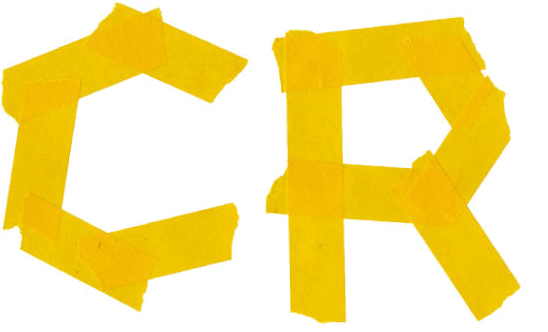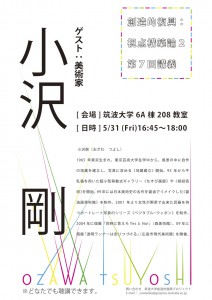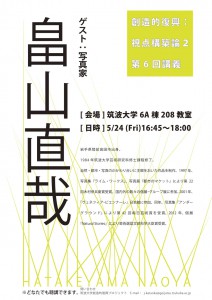The exhibition, “India x Art x School, Wall Art Festival”, has started. Everyone is invited. Please come and see the exhibition. (Akagi)
Date & Time: Oct. 7, Monday ~ Oct. 15, Tuesday, 9:00~18:00
Venue: 6A Entrance Gallery
Panel Discussion: “Art inspired by communication and its possibilities”
Date & Time: Oct. 15, Tuesday, 18:30~20:30
Venue: Tsukuba University, 6A208
Contents: A panel discussion will be held, inviting as guests the organizers and participating artists of the Wall Art Project. After the event, a social gathering will be held at another venue.
*Everyone is invited to participate.



Category Archives: Notifications
“Wall Art Festival” Exhibition
“Wall Art Festival” Exhibition”, led by Misayo Tanaka, a 2nd year student at the University of Tsukuba Graduate School, has started.
“India x Art x School, Wall Art Festival”
Date & Time: Oct. 7, Monday ~ Oct. 15, Tuesday, 9:00~18:00
Venue: 6A Entrance Gallery
Date & Time: Oct. 15, Tuesday, 18:30~20:30
Venue: Tsukuba University, 6A208
Contents: A panel discussion will be held inviting as guests the organizers and participating artists of the Wall Art Project. After the event, a social gathering will be held at another venue.
Wall Art Festival is an art festival featuring the slogan, “Art x School x Support! Smiles connected by Art. Kizuna (Bonds of friendship) created by Art”. It has been held 4 times in schools in Indian villages where the educational system and infrastructures are still developing. The first one was held in Feb. 2010, and from then on, the art festival has been held once a year. The first 3 were held in the village of Sujata, Bihar, India, the 4th in the village of Ganjad, Thana, Maharashtra, India, and next year, in 2014, we will be holding it in the village of Ganjad again.
The story of this art festival began when 50 Japanese students donated a school building to a small village in India. It was some time after that they came to realize that the most important thing was not to construct a school building but to give support after the construction. “We must do something!” It was this thought that led to the art festival, where the walls of the school buildings are used as canvases. A festival that can be held anywhere where there is a white wall. With the theme, “Art x School x Support!”, our ambition is to spread, throughout the world, art that cannot be converted into money. (From “Wall Art Festival Book: the Miracle of the White Walls of India”.)
This project was not set up in response to the earthquake and its goal is not particularly about the earthquake disaster reconstruction. However, in terms of it being an attempt to study how people can be connected through art, the Creative Reconstruction and Wall Art Festival share a common goal. After the earthquake occurred in 2011, “Wall Art Festival in FUKUSHIMA” was held at “Big Palette FUKUSHIMA” in Koriyama-city, Fukushima, on May 28, 29 of that year. Messages from India to the refugees were delivered, and exhibitions, live shows and workshops by artists who took part in WAF 2011 were also held. The success of this event is based on the connections fostered by the “Communication through Art” carried out in India. Connections that developed through communication should naturally lead to the next connection and so on. It is this sort of sincerity and the cycle driven by the passion of the people involved that dynamically advance the art festival. Having been given the opportunity to introduce the activities of the Wall Art Festival at this gallery, it would be a blessing if every person who came by were inspired or touched in some way. Please take your time to look around.
Master’s Program in Art & Design, Plastic Art and Mixed Media, 2nd Year.
Wall Art Festival 2014 Report Program in Tsukuba University, Japan
Misayo Tanaka

FUKUSHIMA VOICE Filming Practice
Members of the documentary film project “FUKUSHIMA VOICE” carried out a film-shooting camp from Sept. 1 to 8. On the first day, “Mirai Kaigi (Future Meeting) in Iwaki x FUKUSHIMA VOICE” was held and the Mirai Kaigi was filmed. The Mirai Kaigi will be the pillar of this film.
[Mirai Kaigi (Future Meeting) in Iwaki x FUKUSHIMA VOICE]
https://www.facebook.com/events/1396182743935344/

The students experienced first hand the unique atmosphere of each shooting and learned a lot of things including camera-work and how to connect with their subjects. As the days went by, their will to create a good film became stronger. Through our reporting, we not only learned about the earthquake and its effects, but also about the life of the subjects, and felt the enormous responsibility of recording on film as well as the profound depth involved in film-making.
At the film-shooting camp, we were blessed with support from a wide range of people. We would like to thank the people in Iwaki who agreed to talk to us and to those who gave us support. We will work on consolidating all your voices into one. The film is due to be completed and ready for show at the end of November. To deliver the voices of Fukushima throughout the world, we intend to continue working together very hard. (Hashimoto)




THE Party “Da Vinci Exercises” YouTube
On the weekend of July 27-28, we held the Weekend Art School in Tsukuba. Feel, see and become Leonardo da Vinci!?! A great hit during this weekend was the “Da Vinci Exercises,” led by musicians THE Party. An edited video is now up on YouTube.
Be sure to check out these fun “Da Vinci Exercises” ! (Akagi)
FUKUSHIMA VOICE in progress!
With the outline of the documentary FUKUSHIMA VOICE decided upon, the students have divided into 4 teams in order to start actually tackling the project. On the 1st of September, we will organise in the city of Iwaki a Iwaki future meeting ×FUKUSHIMA VOICE that will be aimed at providing footage for the documentary, and the accumulation of the voices that will raise during the meeting will be aprehended undertaken as a whole. Then by also observing the individual participants, we will try to depict through this film both the “individual voice” of each person, and the “big voice” created by the gathering of each individual voice. Participants to the Iwaki future meeting can be coming from Iwaki city as well as outside the city. Please come and tell us your stories.
(Hashimoto)

Iwaki future meeting ×FUKUSHIMA VOICE
http://www.facebook.com/events/1396182743935344?notif_t=plan_admin_added/
Iwaki future meeting. Details here.
http://www.facebook.com/miraikaigi/
A Creative Reconstruction: Vision Formulation 2, 10th session announcement and information about related exhibitions
For the 10th (and last) session of Vision Formulation 2, we will welcome the artist Mr. Yoshiaki Kaihatsu. Since the disaster of 2011 and the nuclear accident, Mr Kaihatsu has been putting a lot of energy in implementing a large variety of projects : “Dailily Art Circus” for which he has piled up artworks in a truck and driven across Japan to hold charity exhibitions; “Politicians’ House” involving opening every 15th of the month a free of charge rest area reserved to the politicians in Soma city, Fukushima prefecture; “The Words Library” for which he has interviewed people from the coastal areas from Aomori to Fukushima; “Kita-Yakata Kagura(japanese divine dance) : the Beginning of the End”, a DVD in which he directed the recording the Shishi-Kagura(Lions Dance) of Kita-Yakata in the Kashima district of the City of Minami-Soma, etc.
“A Creative Reconstruction: Vision Formulation 2, 10th session. Guest: Yoshiaki Kaihatsu”
Location : University of Tsukuba [Bldg 6A, Room 208]
Friday, June 28th @ 4:45pm〜6:00pm
During the Vision Formulation 2 session, we will screen “Kita-Yakata Dance : the Beginning of the End”, a movie made in order to re-introduce the dances of Kita-Yakata, traditional performances which have been alive in the district of Kashima, city of Minami-Soma in Fukushima prefecture.
“Kita-Yakata Kagura : the Beginning of the End ”
Location: University of Tsukuba [Bldg 6A, Entrance Gallery]
Tuesday, June 25th to Friday, June 28th, 10:00Am〜5:00pm
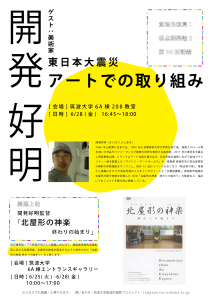
(Kataoka)
Inspection tour in Sanriku
This year too, on June 1st and 2nd, we organised an inspection tour of two days in Sanriku. We wanted to see with our own eyes how the situation was in the stricken areas two years after the disaster. This year, 40 people took part in the tour, students and teachers all together.
On the first day, we visited the “recovery shopping street” of Ishinomaki city, and the participants had lunch in the shopping street restaurants or at the cafeterias run by students. Then we headed to the district of Kadowaki, a coastal area of Ishinomaki, visited the Kadowaki primary school, and also “Don’t give up Ishinomaki / ARIGATOU House”, and we got a chance to ask Mr Ogata, in charge of the “ARIGATOU House” about his experience of the disaster. We will remember that he feels that there is a gap between the reality of the situation and what is broadcast, and also him saying, “Rather than next year or the year after, I want to know what tomorrow will be like.” Compared to last year, the mountains of debris had shrunk, the ruins of the buildings that were taken away by the tsunami were replaced by wide grass fields and empty lands, and the absence of people left us with a strong impression of sadness.
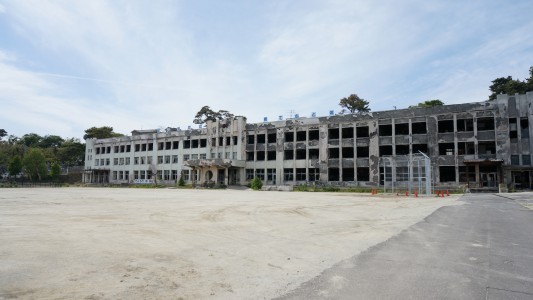
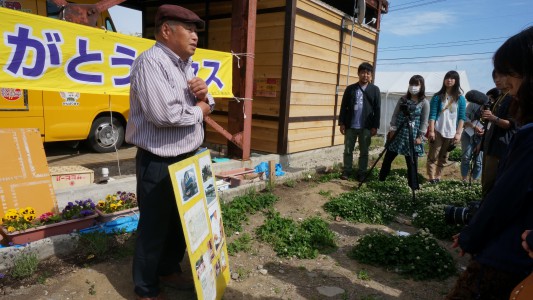
After we entered the Oshika Peninsula where we were to stay, we heard from the people that are carrying volunteer activities in the area, about the state of confusion just after the disaster, and the current problem of decrease of population, and how this issue is addressed.
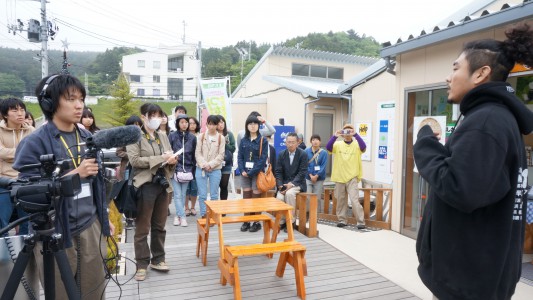
After dining at the hotel, each participant talked about his/her impression of the first day. Some said “Even though I’m here, I still couldn’t believe it was true. I felt how difficult it is to imagine. ” “I felt helplessness.”, “I was able to verify with my own eyes, and not through the media.” and expressed feelings of perplexion, and it was a very constructive time for everybody to be able to share opinions.
On the second day, we first visited Onagawacho, and saw the building that the tsunami had knocked down and left as a mere iron frame. We then went to the “recovery shopping street” of the Minami-Sanriku district, had a nice local lunch, and gathered again at the temporary housing of Prof. Ando.

Finally, we visited the production place of Ono-kun from Higashi-Matsushima, and the sight of the temporary housing inhabitants happily making the dolls freed us from the feeling of helplessness we had the first day, giving us hope that recovery can be reached if we started by whatever little things we can do.
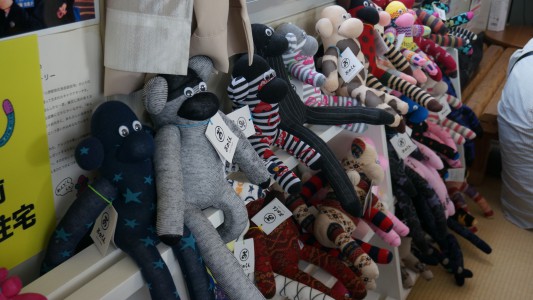
We would like to thank all the people that helped us with this trip to Sanriku and told us precious stories and useful advice. I hope that the way the participant students will share what they saw with their own eyes during this trip with the rest of the team, will help push further our activities.
(Hashimoto)
Announcement : A Creative Reconstruction: Vision Formulation 2, 8th session
For the 8th session of Creative Reconstruction: Vision Formulation, we are honored to welcome Prof. Momoyo Kaijima, associate professor at Tsukuba University and also architect. After the disaster, Prof. Kaijima participated in a network of architects for relief and recovery called Archi+Aid, and helped regions such as Momonoura in the Oshika Peninsula, Tsukinoura, and the area of Samuraihama. He will tell us about his activities, and everybody is welcome to join the lecture.
Location : University of Tsukuba [Bldg 6A, Room 208]
Friday, June 7th @ 4:45pm〜6:00pm
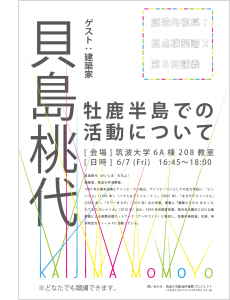
(Kataoka)
